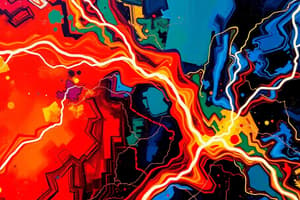Podcast
Questions and Answers
What is the unit of electric current?
What is the unit of electric current?
- Coulomb
- Watt
- Volt
- Ampere (correct)
Which of the following factors does NOT affect the electromotive force (emf) of a cell?
Which of the following factors does NOT affect the electromotive force (emf) of a cell?
- Nature of chemicals used
- Size of the cell (correct)
- Number of cells
- Temperature
What does the internal resistance of a cell determine?
What does the internal resistance of a cell determine?
- The voltage of the external circuit
- The distance between electrodes
- The maximum current that can be supplied by the cell (correct)
- The amount of chemical in the cell
What is the definition of terminal potential difference?
What is the definition of terminal potential difference?
Which relationship correctly describes the maximum current from a cell?
Which relationship correctly describes the maximum current from a cell?
What is the effect of stronger electrolytes on the internal resistance of a cell?
What is the effect of stronger electrolytes on the internal resistance of a cell?
Which of the following describes the relationship between internal resistance and area of electrodes?
Which of the following describes the relationship between internal resistance and area of electrodes?
Which of the following correctly defines lost volts?
Which of the following correctly defines lost volts?
Flashcards are hidden until you start studying
Study Notes
Current Electricity Overview
- Involves the flow of electrons or charges through a conductor.
- Electric current ( I ) measures the rate of electric charge flow in a circuit, represented by the formula: ( I = \frac{Q}{t} ) where ( Q ) is electric charge and ( t ) is time.
- Unit for current is the ampere (A), equivalent to ( \text{C s}^{-1} ).
Potential Difference and Electromotive Force
- Terminal potential difference (voltage) ( V ) represents the work done in moving a unit charge across two points in a circuit.
- Electromotive force (emf) ( E ) is the total work done per unit charge in a complete circuit: ( E = \frac{W}{Q} ) with ( W ) as work done.
- Voltage in a circuit not delivering current, or open circuit, is also described by emf.
- The unit of potential difference is the volt (V).
Factors Affecting Emf of a Cell
- Depends on the quality of chemicals or materials in the cell; stronger electrolytes result in lower internal resistance and greater emf.
- Influenced by the number of cells, time, and temperature; emf decreases with time and increasing temperature, such as in primary cells.
Internal Resistance
- Internal resistance ( r ) is the opposition to current flow caused by the cell producing the current.
- Determinants include:
- Nature of chemicals or electrodes.
- Amount and size of chemicals or electrodes.
- Area of electrodes; internal resistance is inversely proportional to area (( r \propto \frac{1}{A} )).
- Distance between electrodes; internal resistance is proportional to distance (( r \propto d )).
- Higher internal resistance limits the maximum current supplied by the cell, as described by the equation: ( I_{\text{max}} = \frac{E}{r} ).
Lost Volts and External Resistance
- Lost volt ( v ) refers to the potential difference across the internal resistance of a cell.
- External resistance ( R ) is the opposition encountered by current in a material, affecting the overall circuit performance.
Studying That Suits You
Use AI to generate personalized quizzes and flashcards to suit your learning preferences.




